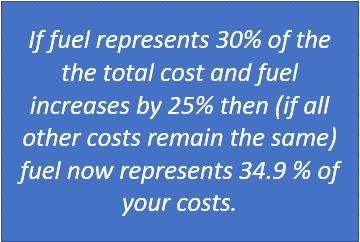By Robert Hind
Does your contract Rise and Fall let you down?
When you’re providing products or services in a long term relationship there is usually a contract which will typically include an Escalation (Rise and Fall) formula. The intent of the Escalation Formula is that cost increases or decreases should be passed on so that the contract pricing is fair to all parties (the seller, the buyer and even sub-contractors to the seller).
Excel models are used to track movement of indices but often use flawed thinking. The two most common errors are:
- Fixed factor basis. Many Rise and Fall formulae include fixed factor declaration ..but cost components rarely change at the same rate. For example: If fuel represents 30% of the the total cost and fuel increases by 25% then (if all other costs remain the same) fuel now represents 34% of your costs.
- Discounting fixed costs. Some formulae allow say factors totalling only 90% on the basis that administration or profit are 10% and should be fixed. This is flawed thinking and results in further erosion.

Well ..what is the answer? In my opinion the only fair (fair for all parties) solution is an adjusting factor formulae. Over many years I worked with contract Rise and Fall and converting them to adjusting factor formulae was a “win/win” for all concerned.
Building Excel systems and rise and fall models which keep track of indices and their movements and apply an adjusting factor formulae will ensure your business recovers cost increases, passes on savings and consequently builds trust and relationships through integrity.
If you’re interested in protecting your profits and being fair to customers lets have a discussion?








